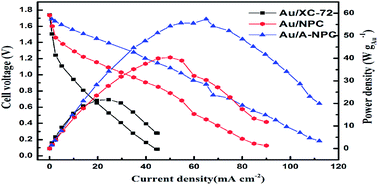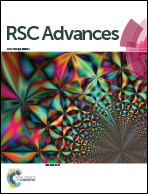Performance improvement of activated nanoporous carbon supported gold catalyst as an anode for direct borohydride–hydrogen peroxide fuel cells
Abstract
Activated nanoporous carbon (A-NPC) has been synthesized via KOH activation of a nanoporous carbon (NPC) prepared using a template metal–organic framework-5 (MOF-5), and it is firstly used as an anode electrocatalyst carrier of Au nanoparticles in borohydride–hydrogen peroxide fuel cells (DBHFCs). The samples are characterized by N2 adsorption–desorption isotherms, transmission electron microscopy (TEM), X-ray diffraction (XRD), cyclic voltammetry (CV), chronopotentiometry (CP), chronoamperometry and fuel cell tests. It has been found that the A-NPC achieves a surface area up to 2296 m2 g−1 and a pore volume of 1.59 cm3 g−1. The mean particle size of Au crystallites dispersed uniformly on the surface of the A-NPC carrier is only 2.9 nm. Besides, the peak current density for direct borohydride oxidation of the Au/A-NPC (49.1 mA cm−2) is 13.6% higher than that of the untreated NPC supported Au (43.2 mA cm−2), and 63.1% higher than that of commercial Vulcan XC-72R supported Au (30.1 mA cm−2). The DBHFC using the Au/A-NPC as anode electrocatalyst can obtain a maximum power density of 48.2 mW cm−2 at 25 °C.


 Please wait while we load your content...
Please wait while we load your content...